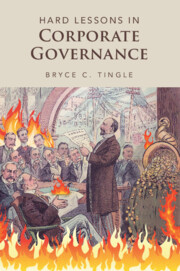Book contents
- Hard Lessons in Corporate Governance
- Hard Lessons in Corporate Governance
- Copyright page
- Dedication
- Contents
- Acknowledgments
- Editorial Note
- Introduction
- 1 Our Corporate Governance Experiment
- Part I What Do We Know about Corporate Governance Practices?
- 2 Best Practices for Boards of Directors
- 3 Can We Measure Corporate Governance?
- 4 Do We Understand Executive Compensation Best Practices?
- 5 What Explains Shareholder Voting?
- 6 Shareholder Activism
- 7 Proxy Advisors
- Part II What Can We Conclude about Our Theories of Corporate Governance?
- Part III Are Social Welfare Outcomes Any Different?
- Index
5 - What Explains Shareholder Voting?
from Part I - What Do We Know about Corporate Governance Practices?
Published online by Cambridge University Press: 23 May 2024
- Hard Lessons in Corporate Governance
- Hard Lessons in Corporate Governance
- Copyright page
- Dedication
- Contents
- Acknowledgments
- Editorial Note
- Introduction
- 1 Our Corporate Governance Experiment
- Part I What Do We Know about Corporate Governance Practices?
- 2 Best Practices for Boards of Directors
- 3 Can We Measure Corporate Governance?
- 4 Do We Understand Executive Compensation Best Practices?
- 5 What Explains Shareholder Voting?
- 6 Shareholder Activism
- 7 Proxy Advisors
- Part II What Can We Conclude about Our Theories of Corporate Governance?
- Part III Are Social Welfare Outcomes Any Different?
- Index
Summary
This chapter considers the consequences of the low-to-non-existent marginal value of shareholders’ individual voting power in America’s widely held companies. It reviews the empirical literature on rational ignorance and rational irrationality in civic voting. It argues that we should expect similar levels of ignorance and irrationality in shareholder voting. The chapter then considers the evidence for this ignorance and irrationality in: (1) various measures of the value shareholder put on their voting rights; (2) what appears to drive voting outcomes in uncontested director elections; (3) the failure of shareholders to meaningfully hold directors accountable for failures and fraud; (4) the changes in the voting behavior of shareholders once majority voting is introduced; (5) shareholder responses to boards refusing to accept the resignation of a director who loses an election; (6) the evidence that contested director elections (proxy fights) have nothing to do with corporate governance; (7) the ways the economic decisions of shareholders are at variance with their voting behavior; and (8) the evidence shareholders do not pay attention to their own votes, and generally try to keep them purely symbolic.
Keywords
- Type
- Chapter
- Information
- Hard Lessons in Corporate Governance , pp. 93 - 117Publisher: Cambridge University PressPrint publication year: 2024

